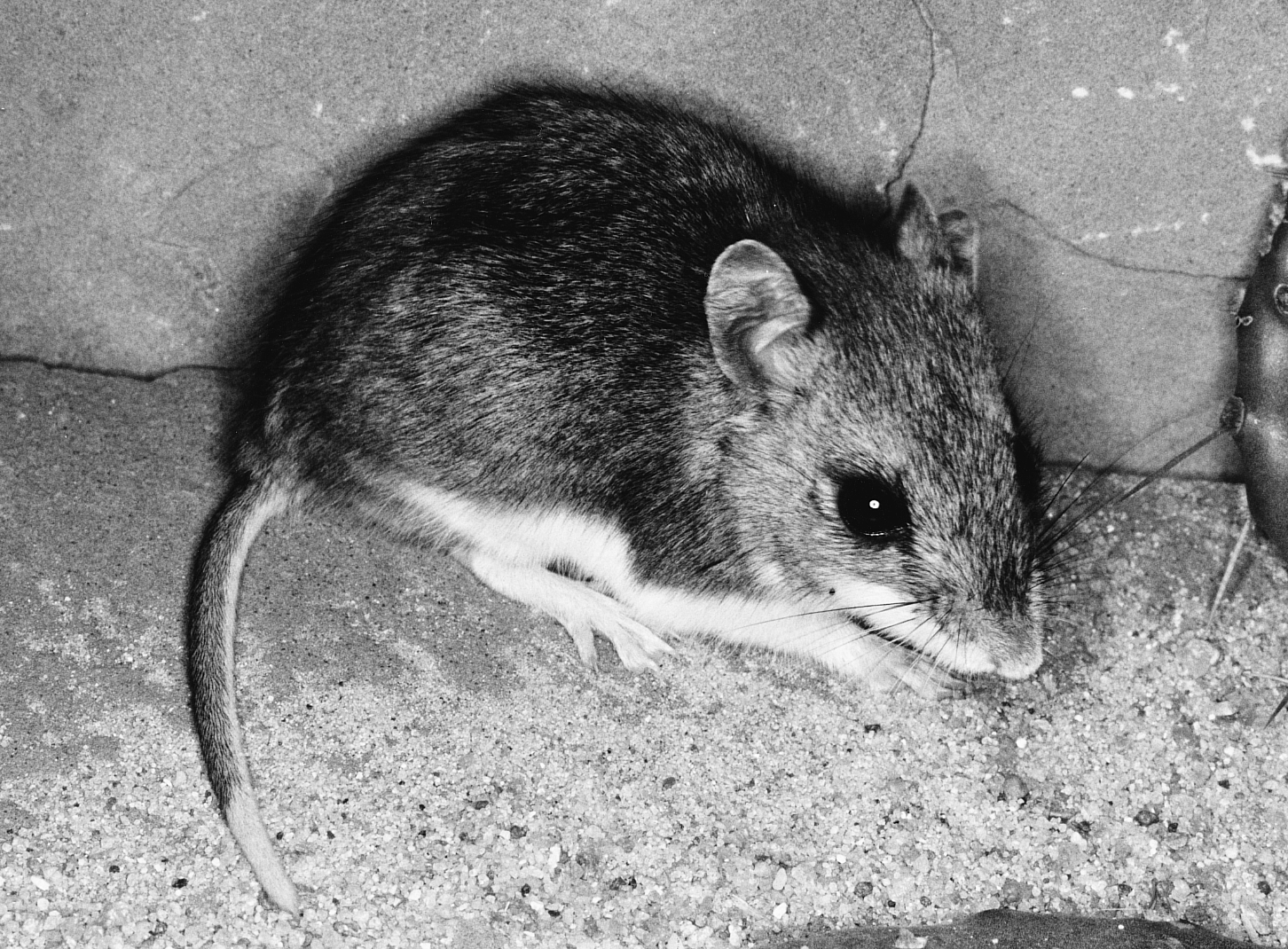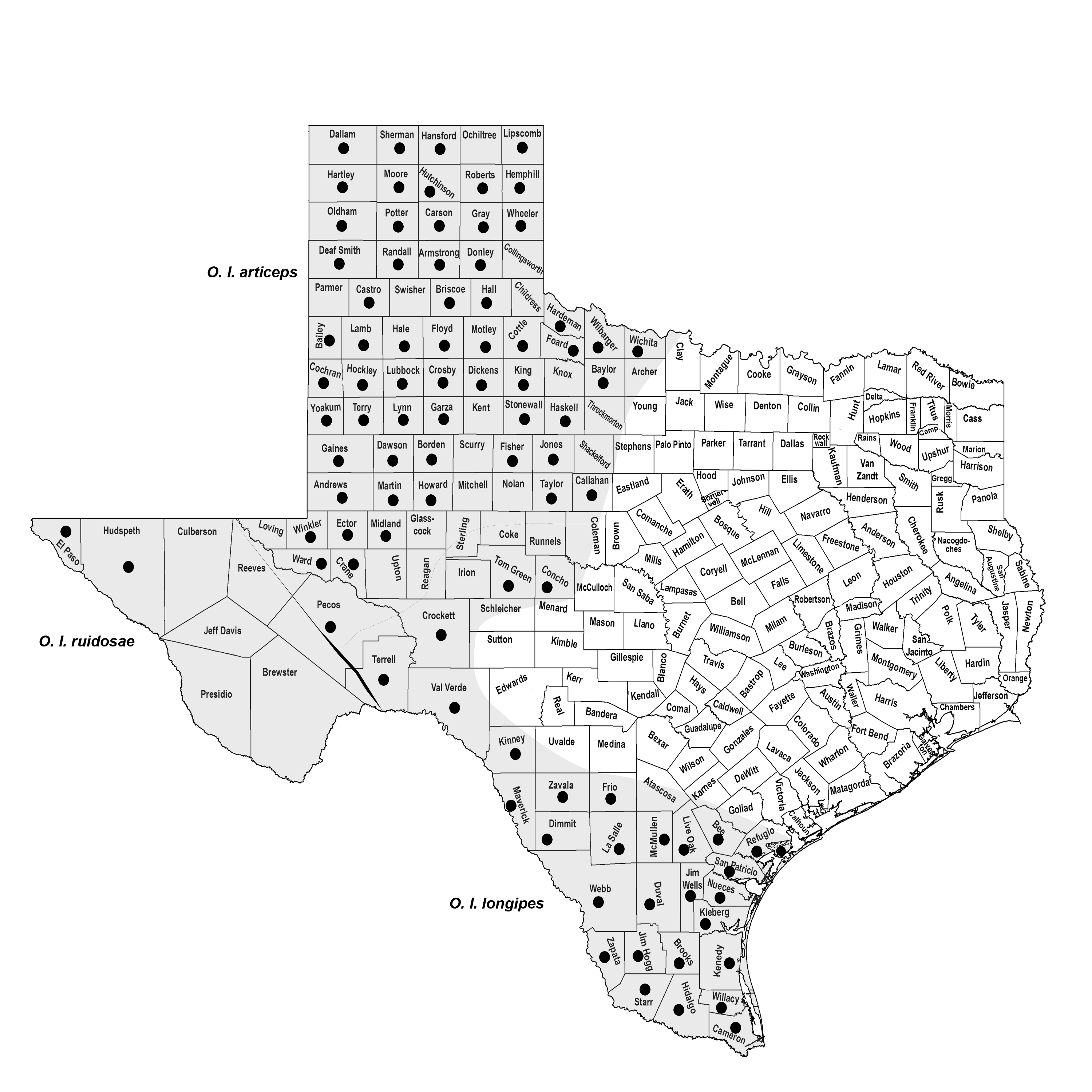NORTHERN GRASSHOPPER MOUSE
Onychomys leucogaster (Wied-Neuwied 1841)
Order Rodentia : Family Cricetidae
DESCRIPTION. A stout-bodied, short-tailed mouse similar to O. arenicola but larger, heavier, and shorter tailed; upperparts drab brown; the nose, sides, cheeks, and underparts white; tuft at anterior base of ear white and conspicuous; tail usually <30% of total length and usually 1.5–2 times as long as hind foot. Dental formula: I 1/1, C 0/0, Pm 0/0, M 3/3 × 2 = 16. Averages for external measurements: total length, 164 mm; tail, 42 mm; hind foot, 22 mm. Weight, 27–46 g, occasionally as much as 52 g.

DISTRIBUTION. Throughout most of western Texas (no specimens yet documented from the central part of the Trans-Pecos) and the Rio Grande Plains of South Texas.

SUBSPECIES.Onychomys l. ruidosae in El Paso and Hudspeth counties, O. l. arcticeps in the Panhandle and adjacent areas to the east, south to Crockett and Pecos counties, and O. l. longipes from Tom Green and Terrell counties southward to the Rio Grande and southeastward to Nueces County.
HABITS. These predatory mice occur primarily in association with sandy or powdery soils in grasslands or open brushlands, but they are never very common as compared with other small mammals. Recently RDB and students captured 18 from a 5 ha old-field habitat, indicating that occasionally they may experience population booms.
They are wanderers and travel continuously throughout their territory. They are reputed to usurp the burrows of other small mammals rather than take the time to construct their own. They have a rather pugnacious disposition. Vernon Bailey attributed to them many of the habits of the weasel and compared one of their calls to the howl of a wolf, "made with raised nose and open mouth in perfect wolf form." Because of their short legs and chunky body, they are not fleet-footed, but they are expert at dodging, twisting, and turning and in close quarters can easily capture and overpower other mice their own size or even larger.
As the name implies, one of their chief food items in season is grasshoppers. In addition, numerous other kinds of insects, scorpions, small mice, and a variety of plants contribute to their diet. Captives are especially fond of raw liver and newborn mice. Vernon Bailey and Charles Sperry reported that animal matter makes up nearly 89% of their natural food, plant material only 11%.
The breeding season extends at least from February to October, as judged from pregnancy records, and breeding may occur throughout most of the year in some parts of its range within Texas. Three to six litters of young may be produced annually, but the bulk of the young are born in May and June. The litter size varies from two to six, averaging about four.
The gestation period varies from 32 to 47 days, with the longer periods in lactating females. At birth, the young are pink and hairless (except for the prominent vibrissae) and weigh about 2 g each. The eyes and ears are closed, and the tail is characteristically short and thick. Within 3 days the ears unfold, but the eyes remain closed until the 19th or 20th day, at which time the young mice are almost weaned. They are probably evicted from the nest shortly thereafter. Sexual maturity is reached in about 3 months, when the mice are still in the soft, gray juvenile pelage.
Because of their fondness for insects and small mice, their economic status is either neutral or beneficial.
POPULATION STATUS. Common. Although a common inhabitant of west and South Texas, the northern grasshopper mouse seldom occurs in large numbers. Its infrequent capture may be due to the fact that it fills a carnivore-like niche and therefore occurs naturally in relatively low numbers.
CONSERVATION STATUS. The IUCN lists the northern grasshopper mouse as a species of least concern, and it does not appear on the federal or state lists of concerned species. This grasshopper mouse appears to be in good shape throughout its range in Texas.
From The Mammals of Texas, Seventh Edition by David J. Schmidly and Robert D. Bradley, copyright © 1994, 2004, 2016. Courtesy of the University of Texas Press.
Natural Science Research Laboratory
-
Address
Museum of Texas Tech University, 3301 4th street, Lubbock, TX 79409 -
Phone
806.742.2486 -
Email
nsrl.museum@ttu.edu

